Differences in Dry Sliding Wear Behavior between Al–12Si–CuNiMg Alloy and Its Composite Reinforced with Al2O3 Fibers
Abstract
1. Introduction
2. Materials and Experimental Procedures
2.1. Materials
2.2. Wear Tests
3. Results and Discussion
3.1. Wear Behavior
3.2. Friction Behavior
3.3. Worn-Surface Analysis
4. Conclusions
- (1)
- Under the present testing conditions, the wear rate of the Al2O3 fiber-reinforced composite was relatively higher than that of the Al–12Si–CuNiMg matrix alloy. This phenomenon could be attributed to the high content of Al2O3 fibers and casting porosities in the composite.
- (2)
- The wear rate of the composite decreased with increasing sliding velocity. With regard to the matrix alloy, the wear rate exhibited a distinct increase with increasing sliding velocity.
- (3)
- The friction coefficient of the two materials decreased as sliding velocity increased. Furthermore, the friction coefficient significantly decreased for both materials with increasing load. Compared with that of the matrix alloy, the friction coefficient of the composite was relatively higher due to the formation of tribofilm on the counterface.
- (4)
- Under present testing conditions, the dominant wear mechanisms for both materials were abrasive wear and adhesion wear.
Author Contributions
Funding
Conflicts of Interest
References
- Dwivedi, D.K. Adhesive Wear Behavior of Cast Aluminum-Silicon Alloys: Overview. Mater. Des. 2010, 31, 2517–2531. [Google Scholar] [CrossRef]
- Gómez, P.; Elduque, D.; Sarasa, J.; Pina, C.; Javierre, C. Influence of Composition on the Environmental Impact of a Cast Aluminum Alloy. Materials 2016, 9, 412. [Google Scholar] [CrossRef]
- Du, J.; Liu, Y.H.; Yu, S.R.; Li, W.F. Dry Sliding Friction and Wear Properties of Al2O3 and Carbon Short Fibres Reinforced Al-12Si Alloy Hybrid Composites. Wear 2004, 257, 930–940. [Google Scholar]
- Baradeswaran, A.; Elaya Perumal, A. Study on mechanical and wear properties of Al 7075/Al2O3/graphite hybrid composites. Compos. Part B Eng. 2014, 56, 464–471. [Google Scholar] [CrossRef]
- Park, B.G.; Crosky, A.G.; Hellier, A.K. High cycle fatigue behaviour of microsphere Al2O3-Al particulate metal matrix composites. Compos. Part B Eng. 2008, 39, 1257–1269. [Google Scholar] [CrossRef]
- Moldovan, P.; Dragut, D.V.; Butu, M.; Besea, L.M.; Preda, E.A. In situ development of AlBX/AA6060 and AA5083 alloys cast composites. Compos. Part B Eng. 2016, 97, 9–17. [Google Scholar] [CrossRef]
- Miyajima, T.; Iwai, Y. Effects of reinforcements on sliding wear behaviour of aluminium matrix composites. Wear 2003, 255, 606–616. [Google Scholar] [CrossRef]
- Hu, J.; Xin, L.; Han, J.L.; Lu, Y.H. Effect of Cold Rolling on the Fretting Wear Behavior and Mechanism in Inconel 690 Alloy. Tribol. Trans. 2019. [Google Scholar] [CrossRef]
- Muhammad, U.B.; Zulfiqar, A.K. Nigel GarlandWear performance analysis of Ni-Al2O3 nanocomposite coatings under nonconventional lubrication. Materials 2019, 12, 1–22. [Google Scholar]
- Bai, Y.; Wang, Z.H.; Li, X.B.; Huang, G.S.; Li, C.X.; Li, Y. Microstructure and Mechanical Properties of Zn-Ni-Al2O3 Composite Coatings. Materials 2018, 11, 853. [Google Scholar] [CrossRef]
- Raghavendra, N.; Ramamurthy, V.S. Development and Dry Sliding Wear Map for Al 7075/Al2O3 Particulate Composites. Mater. Today 2018, 5, 24104–24113. [Google Scholar] [CrossRef]
- RaviKumar, M.; Reddappa, H.N.; Suresh, R. Mechanical and Wear behavior of Al7075/Al2O3/SiC Hybrid Composite. Mater. Today 2018, 5, 5573–5579. [Google Scholar] [CrossRef]
- Yilmaz, O.; Buytoz, S. Abrasive wear of Al2O3-reinforced aluminium-based MMCs. Compos. Sci. Technol. 2001, 61, 2381–2392. [Google Scholar] [CrossRef]
- Kurşun, A.; Bayraktar, E.; Enginsoy, H.M. Experimental and numerical study of alumina reinforced aluminum matrix composites: Processing, microstructural aspects and properties. Compos. Part B Eng. 2016, 90, 302–314. [Google Scholar] [CrossRef]
- Gasem, Z.M. Fatigue crack growth behavior in powder-metallurgy 6061 aluminum alloy reinforced with submicron Al2O3 particulates. Compos. Part B Eng. 2012, 43, 3020–3025. [Google Scholar] [CrossRef]
- Sannino, A.P.; Rack, H.J. Dry sliding wear of discontinuously reinforced aluminum composites: Review and discussion. Wear 1995, 189, 1–19. [Google Scholar] [CrossRef]
- Akbulut, H.; Durmam, M.; Yilmaz, F. Dry wear and friction properties of Al2O3 short fiber reinforced AI-Si (LM 13) alloy metal matrix composites. Wear 1998, 215, 170–179. [Google Scholar] [CrossRef]
- Hamida, A.A.; Ghoshb, P.K.; Jain, S.C.; Rayb, S. Influence of particle content and porosity on the wear behavior of cast in situ Al(Mn)-Al2O3(MnO2) composite. Wear 2006, 260, 368–378. [Google Scholar] [CrossRef]
- Iwai, Y.; Honda, T.; Miyajima, T.; Iwasaki, Y.; Surappa, M.K.; Xu, J.F. Dry sliding wear behavior of Al2O3 fiber reinforced aluminum composites. Compos. Sci. Technol. 2000, 60, 1781–1789. [Google Scholar] [CrossRef]
- Deuis, R.L.; Subramanian, C.; Yellup, J.M. Dry sliding wear of aluminum composites-a review. Compos. Sci. Technol. 1997, 57, 415–435. [Google Scholar] [CrossRef]
- Perrin, C.; Rainforth, W.M. The effect of alumina fiber reinforcement on the wear of an al-4.3%cu alloy. Wear 1995, 181–183, 312–324. [Google Scholar]
- Hamid, A.A.; Ghosh, P.K.; Jain, S.C.; Ray, S. The influence of porosity and particles content on dry sliding wear of cast in situ Al(Ti)-Al2O3(TiO2) composite. Wear 2008, 165, 14–26. [Google Scholar] [CrossRef]
- Al-Qutub, A.M.; Allam, I.M.; Qureshi, T.W. Effect of sub-micron Al2O3 concentration on dry wear properties of 6061 aluminum based composite. J. Mater. Process. Tech. 2006, 172, 327–331. [Google Scholar] [CrossRef]
- Zhang, Q.; Zuo, Z.X.; Liu, J.X. Stepped-isothermal fatigue analysis of engine piston. Fatigue Fract. Eng. Mater. Stract. 2014, 37, 417–426. [Google Scholar] [CrossRef]
- Zhang, Q.; Zuo, Z.X.; Liu, J.X. Effect of fatigue behavior on microstructural features in a cast Al-12Si-CuNiMg alloy under high cycle fatigue loading. J. Mater. Eng. Perform. 2013, 22, 3834–3839. [Google Scholar]
- Zhang, G.H.; Li, B.C.; Zhang, J.X.; Cai, W. The strain amplitude-controlled cyclic fatigue behavior of Al2O3 fiber reinforced Al-Si alloy composite at elevated temperatures. Prog. Nat. Sci. 2012, 22, 153–159. [Google Scholar] [CrossRef][Green Version]
- Zhang, Q.; Zuo, Z.X.; Liu, J.X. High temperature low cycle fatigue behavior of a cast Al-12Si-CuNiMg alloy. Fatigue Fract. Eng. Mater. Stract. 2013, 36, 623–630. [Google Scholar] [CrossRef]
- Liu, J.X.; Zhang, Q.; Zuo, Z.X. Microstructure evolution of Al-12Si-CuNiMg alloy under high temperature low cycle fatigue. Mater. Sci. Eng. A 2013, 574, 186–190. [Google Scholar] [CrossRef]
- Edalati, K.; Ashida, M.; Horita, Z.; Matsui, T.; Kato, H. Wear resistance and tribological features of purealuminum and Al-Al2O3 composites consolidated by high-pressure torsion. Wear 2014, 310, 83–89. [Google Scholar] [CrossRef]
- Durai, T.G.; Karabi, D.; Siddhartha, D. Wear behavior of nano structured Al(Zn)/Al2O3 and Al(Zn)-4Cu/Al2O3 composite materials synthesized by mechanical and thermal process. Mater. Sci. Eng. A 2007, 471, 88–94. [Google Scholar] [CrossRef]
- Mazahery, A.; Shabani, M.O. Microstructural and abrasive wear properties of SiC reinforced aluminum-based composite produced by compocasting. Trans. Nonferrous. Met. Soc. China 2013, 22, 1905–1914. [Google Scholar] [CrossRef]
- Rosenberger, M.R.; Schvezov, C.E.; Forlerer, E. Wear of aluminium matrix composites under conditions that generate a mechanically mixed layer. Wear 2005, 259, 590–601. [Google Scholar] [CrossRef]
- Rosenberger, M.R.; Florlerer, E.; Schvezov, C.E. Wear behavior of AA1060 reinforced with alumina under different loads. Wear 2009, 266, 356–359. [Google Scholar] [CrossRef]
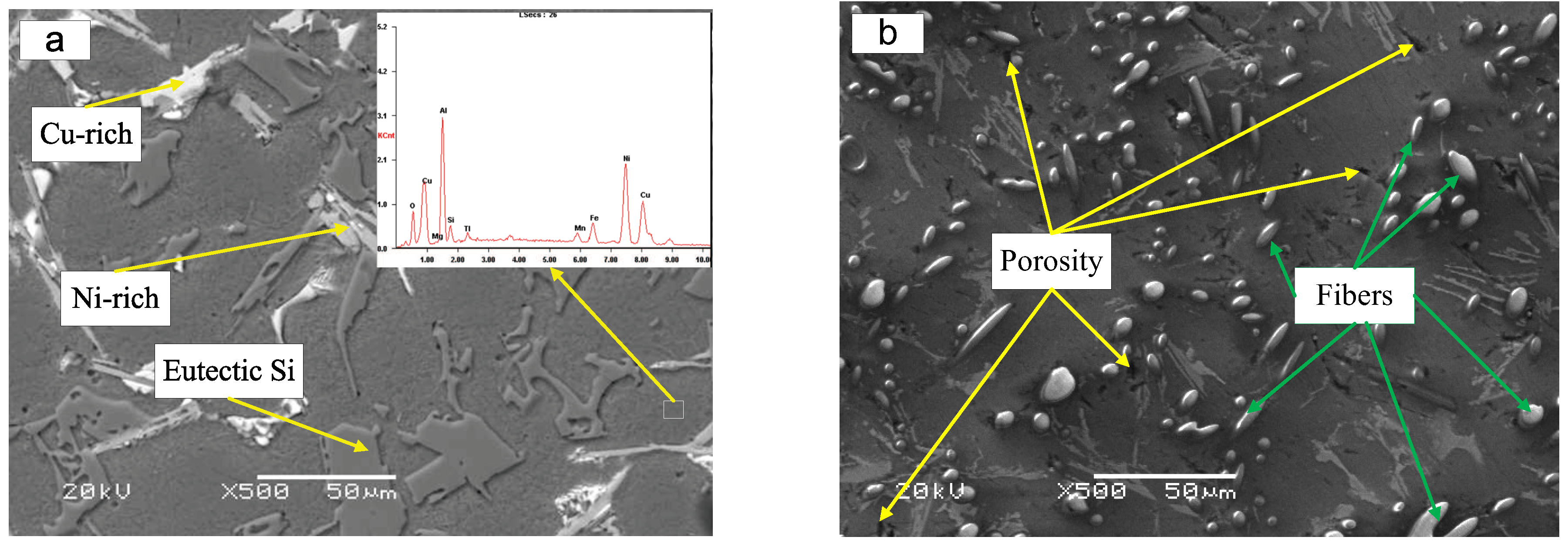
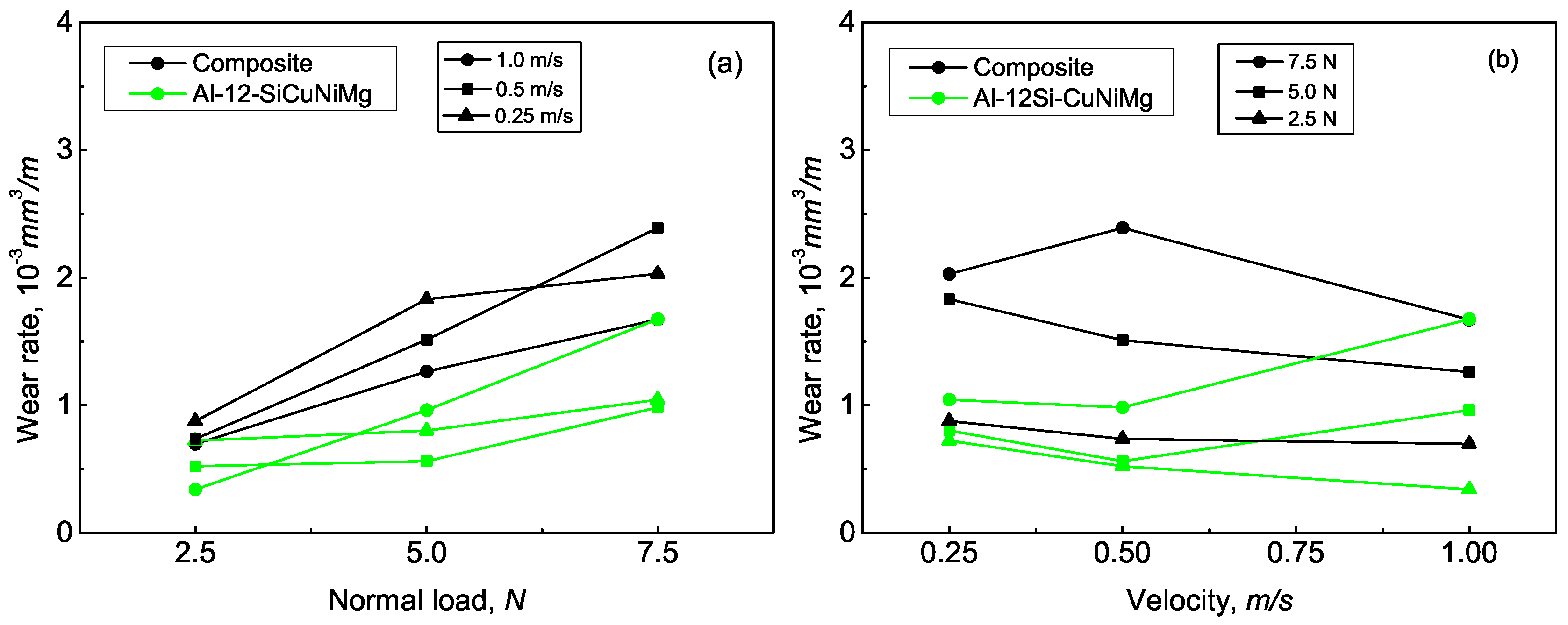
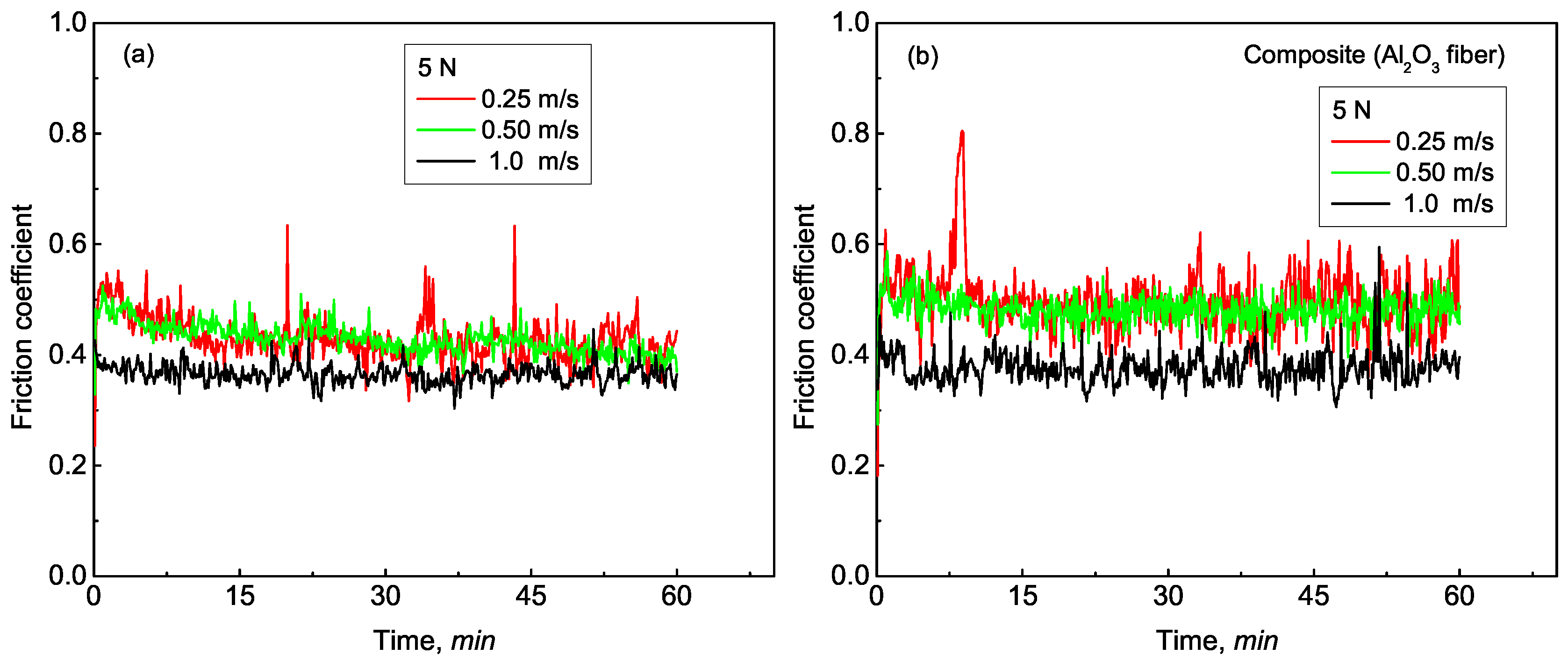


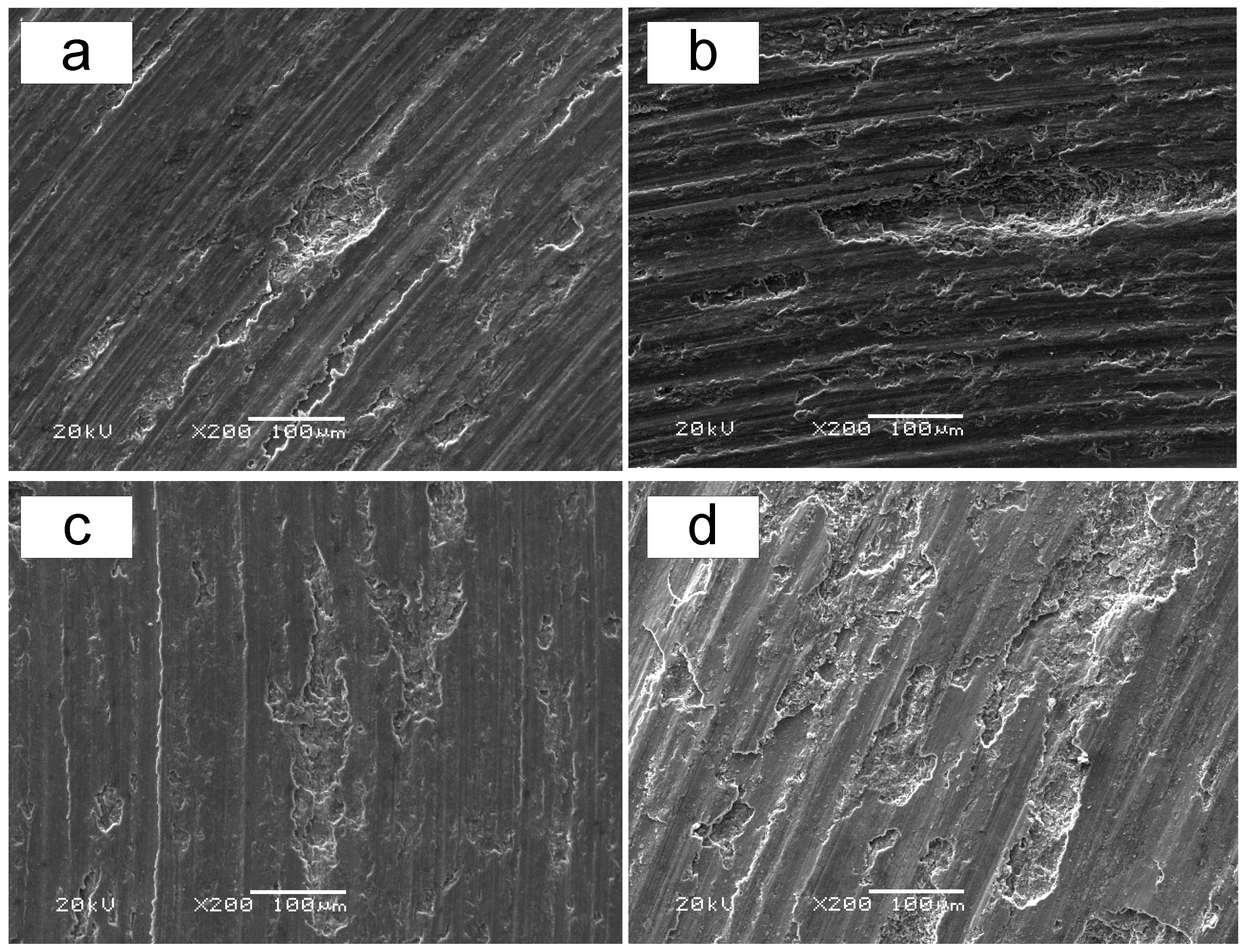
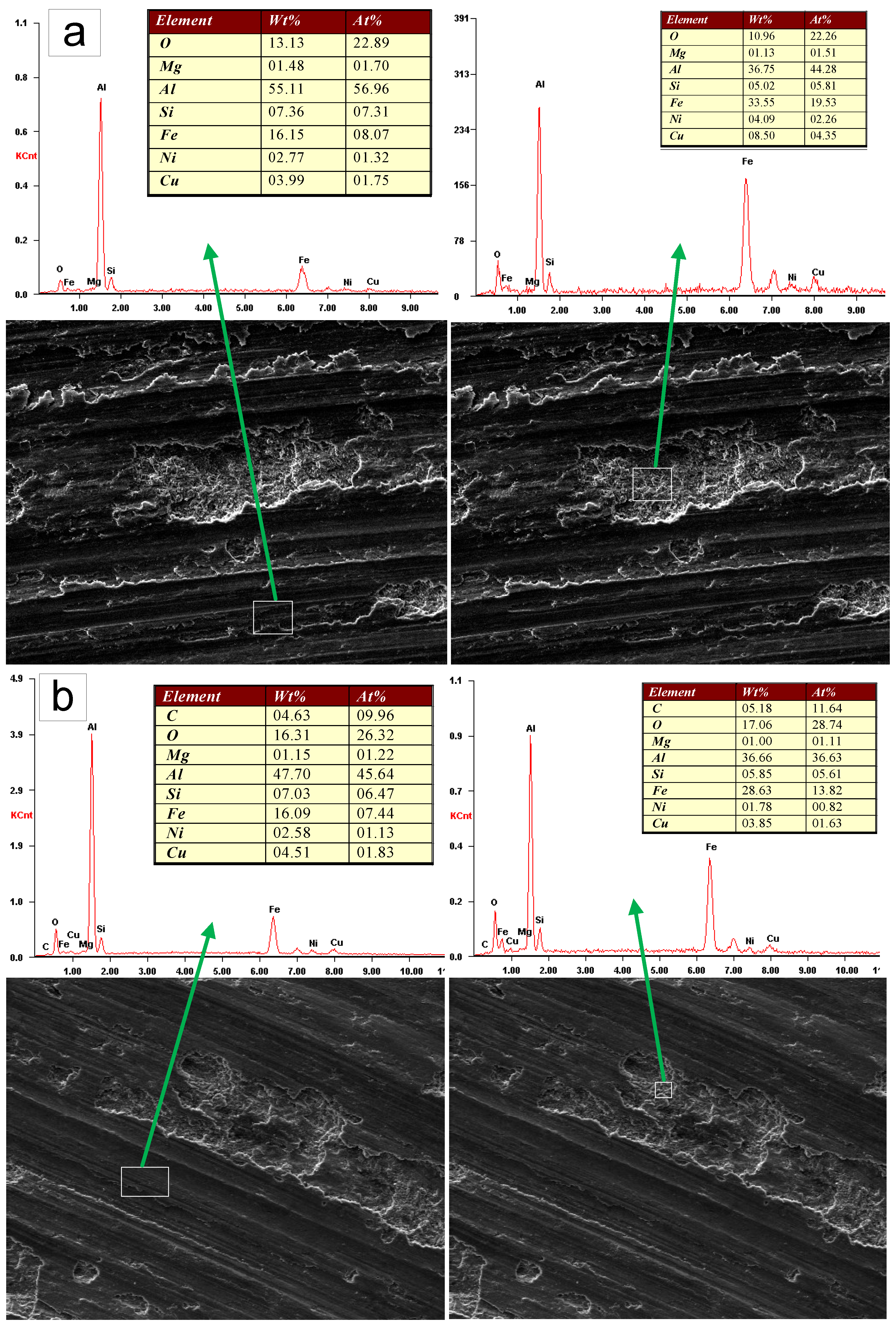
| Si | Cu | Ni | Mg | Fe | Mn | Ti | Zn | Al |
|---|---|---|---|---|---|---|---|---|
| 12.37 | 5.28 | 2.67 | 0.82 | 0.42 | 0.20 | 0.106 | 0.006 | Bal. |
| Material | Ultimate Tensile Strength MPa | Young’s Modulus GPa | Vickers Hardness HV | Density Kg/m3 |
|---|---|---|---|---|
| Matrix alloy | 260 | 80 | 130 | 2770 |
| Composite | 287 | 88 | 160 | 2790 |
© 2019 by the authors. Licensee MDPI, Basel, Switzerland. This article is an open access article distributed under the terms and conditions of the Creative Commons Attribution (CC BY) license (http://creativecommons.org/licenses/by/4.0/).
Share and Cite
Zhang, Q.; Gu, J.; Wei, S.; Qi, M. Differences in Dry Sliding Wear Behavior between Al–12Si–CuNiMg Alloy and Its Composite Reinforced with Al2O3 Fibers. Materials 2019, 12, 1749. https://doi.org/10.3390/ma12111749
Zhang Q, Gu J, Wei S, Qi M. Differences in Dry Sliding Wear Behavior between Al–12Si–CuNiMg Alloy and Its Composite Reinforced with Al2O3 Fibers. Materials. 2019; 12(11):1749. https://doi.org/10.3390/ma12111749
Chicago/Turabian StyleZhang, Qing, Jie Gu, Shuo Wei, and Ming Qi. 2019. "Differences in Dry Sliding Wear Behavior between Al–12Si–CuNiMg Alloy and Its Composite Reinforced with Al2O3 Fibers" Materials 12, no. 11: 1749. https://doi.org/10.3390/ma12111749
APA StyleZhang, Q., Gu, J., Wei, S., & Qi, M. (2019). Differences in Dry Sliding Wear Behavior between Al–12Si–CuNiMg Alloy and Its Composite Reinforced with Al2O3 Fibers. Materials, 12(11), 1749. https://doi.org/10.3390/ma12111749




